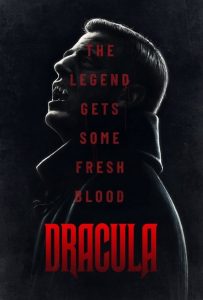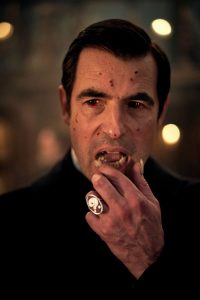 As you may or may not have heard by now, Mark Gatiss and Steven Moffat recently collaborated on yet another TV miniseries adaptation of Bram Stoker’s Dracula — three episodes, produced through the BBC, available right now on Netflix. And much like Gatiss and Moffat’s version of Sherlock Holmes (BBC Sherlock, admired and hated in roughly equal measure by fans around the world, which unleashed both Martin Freeman and Benedict Cumberbatch upon the pop-cultural map), their Dracula is very definitely an audacious, unrepentantly deconstructive spin on the original material. Claes Bang makes a suitably sexy yet essentially predatory Count, as likely to use blunt truth he knows no one “civilized” will ever believe as he is to lie seductively; the explicit sexuality and vibrantly saturated color-scheme recalls Hammer’s formative 1958 boobs-and-blood-heavy reinvention of the genre with Terence Fisher’s Horror of Dracula, while elements of its fairytale-esque yet literally visceral special effects design recall aspects of Neil Jordan’s The Company of Wolves, Terry Gilliam’s The Brothers Grimm, even David Cronenberg’s classic body horror. Add in a cis-swapped Van Helsing, an extended sojourn on the doomed ship Demeter and a time-jump that sends Dracula colliding headlong with the 21st century (“Who told him the WiFi password?!” “Well, it is my name.”), and it’s quite the trip: rollicking, fascinating, amusingly frustrating, frustratingly amusing. Frankly, I loved it.
As you may or may not have heard by now, Mark Gatiss and Steven Moffat recently collaborated on yet another TV miniseries adaptation of Bram Stoker’s Dracula — three episodes, produced through the BBC, available right now on Netflix. And much like Gatiss and Moffat’s version of Sherlock Holmes (BBC Sherlock, admired and hated in roughly equal measure by fans around the world, which unleashed both Martin Freeman and Benedict Cumberbatch upon the pop-cultural map), their Dracula is very definitely an audacious, unrepentantly deconstructive spin on the original material. Claes Bang makes a suitably sexy yet essentially predatory Count, as likely to use blunt truth he knows no one “civilized” will ever believe as he is to lie seductively; the explicit sexuality and vibrantly saturated color-scheme recalls Hammer’s formative 1958 boobs-and-blood-heavy reinvention of the genre with Terence Fisher’s Horror of Dracula, while elements of its fairytale-esque yet literally visceral special effects design recall aspects of Neil Jordan’s The Company of Wolves, Terry Gilliam’s The Brothers Grimm, even David Cronenberg’s classic body horror. Add in a cis-swapped Van Helsing, an extended sojourn on the doomed ship Demeter and a time-jump that sends Dracula colliding headlong with the 21st century (“Who told him the WiFi password?!” “Well, it is my name.”), and it’s quite the trip: rollicking, fascinating, amusingly frustrating, frustratingly amusing. Frankly, I loved it.
I must admit, thought, that part of the subsequent fun for me since watching BBC Dracula has definitely come from watching people freak out on Tumblr not only about Gatiss and Moffat’s usual antics, but also about stuff that’s actually been preserved pretty accurately from Stoker’s original novel, like — SPOILER ALERT for something written over a hundred years ago, I guess — 1) a baby getting killed and 2) Dracula himself being less a sinisterly romantic figure than a ginormous bag of dicks. Not to mention frothing over questions like why isn’t he overtly identified as a version of Vlad “Tsepes” Dracula III of Wallachia, and why can’t he walk around in sunlight, even though he can in the book? And where’s the whole thing about Mina, or Lucy — or Mina-with-Lucy’s name, and/or vice versa — somehow turning out to be a reincarnated version of Dracula’s pre-vampirism wife?
Certainly, this is a reaction at least partially rooted in general fannish “Moftiss” product exhaustion — the received wisdom that Moffat and Gatiss love to screw with canon and audiences alike, to subvert and explode narrative expectations, to ship-tease and queerbait. (Having Jonathan Harker get hypno-roofied and raped by deception is now, apparently, exactly the same as constantly making jokes about Watson and Holmes being mistaken for homosexual lovers without ever delivering on the implication that someday that might become part of the narrative.) I just had a very funny conversation with my husband in which he argued that Stoker’s Dracula is both a magnificent bastard and a total asshole but not as much of a completely preening creep as Moftiss make him. “There’s no Nelson from The Simpsons in Dracula,” he claims, “and the BBC Dracula errs on the distinct side of ‘HA HA!’” Well, the Devil does tend to get all the best lines, doesn’t he? (Or The Master/Missy, on Moffat’s Doctor Who run.)

In my opinion, however, most of this fannish annoyance actually stems from the fact that we’ve already had a century’s worth of other Dracula reinterpretations, many of which have collectively changed the way we feel about how the Dracula narrative “should” go. It was F.W. Murnau’s 1922 film Nosferatu that first claimed Dracula (here called Orlock, to escape plagiarism accusations) could be destroyed by exposure to sunlight, while James L. Balderston and Hamilton Deane’s 1924 stage play was the first version of Dracula to transpose Lucy’s name with Mina’s, make Renfield the person who sold Dracula Carfax Abbey, cut out both Arthur Holmwood and Quincy Morris and set the story’s action within Dr. Seward’s madhouse. And while it’s true that Bram Stoker did pick Dracula-the-character’s name out of his own brief inquiries into Transylvanian history/folklore, a case can be made for the idea that direct identification with Vlad Tsepes might have started with Richard Matheson’s script for Dan Curtis’s 1973 TV movie, starring Jack Palance — hell, even the whole “current bloodlust-object reminds me of [one of my wives]” thing might have started there too, though Francis Ford Coppola’s Bram Stoker’s Dracula (1992) usually takes the brunt of the blame for turning a Let’s All Kill That Monstrous Foreigner Who Wants To Spread His STD To Our Women narrative into a fated doomed romance between Dracula and Mina Murray-Harker. Not to mention how both twists paved the way for the misfired Universal Dark Universe’s crazypants revisionist historical drama Dracula Untold (2014), one of my favorite guilty pleasures.
One way or the other, as Nat Brehmer so aptly points out in his Bloody-Disgusting.com review of the series, that fast-forwarding final episode purists and Moftiss-phobics alike seem to despise so much actually reveals the truth more Dracula adaptations need to internalize: the original book, told in pre-found footage epistolary style as a spate of diary entries, news items and letters from/to various characters, is “nearly…a science fiction novel.” Published in 1897, the cusp of the 20th century, Stoker’s novel is very much about what happens when an old world, folkloric monster is unleashed on the modern world. “There’s almost a degree of fetishizing modernity in the text,” says Brehmer. “Just as many modern techniques are used in the fight against Dracula as old world traditions.” In fact, the book’s Van Helsing initially gives Lucy a blood transfusion in order to save her, a technique not popularized until a few years later (and far more of a gamble than it is today, considering how little people at the time knew about blood types).
 How successful Gatiss and Moffat’s mutual spin in the old Count’s coffin will eventually be reckoned, only time can tell. Yet when I peek a bit further underneath the undeniably enticing yet surprisingly shallow shellack of foe-yay, snark and easy-target satire, I do find more than a hint of something both retrospective and genuinely original: The way that Gatiss, by stripping the word “un-dead” down to both its original meaning and original Slavic European folkloric tropes, ends up with a version of Dracula who manages to be the only revenant around who appears to have retained his original personality essentially because — no matter how many memories or much much knowledge he siphons out of his victims (“blood is lives!”, as he constantly says) — his real original sin lies in not his murders or his seductions but in his own frank refusal to die at all.
How successful Gatiss and Moffat’s mutual spin in the old Count’s coffin will eventually be reckoned, only time can tell. Yet when I peek a bit further underneath the undeniably enticing yet surprisingly shallow shellack of foe-yay, snark and easy-target satire, I do find more than a hint of something both retrospective and genuinely original: The way that Gatiss, by stripping the word “un-dead” down to both its original meaning and original Slavic European folkloric tropes, ends up with a version of Dracula who manages to be the only revenant around who appears to have retained his original personality essentially because — no matter how many memories or much much knowledge he siphons out of his victims (“blood is lives!”, as he constantly says) — his real original sin lies in not his murders or his seductions but in his own frank refusal to die at all.
It’s a blasphemous, unnatural, literally contagious idea that strips away both Dracula’s soul and the souls of his victims by implying that anything must be better than death — that any version of half life is preferable to the grave. It’s like he’s gotten stuck in that developmental stage my mother talks about passing through, where you no longer believe in God or heaven but you also can’t believe that death might simply be the absence of self. So you live with this constant fear of being shut in a box and buried forever, scratching away under the dirt.
So here’s the question: if a ghost is a memory frozen in time (cf Guillermo del Toro), then what — exactly — is a vampire? What are its fundamental characteristics? Every culture on earth has myths about predatory creatures sucking something vital out of us, usually at night, often while we’re asleep, sometimes under the guise of a sexual dream-object. Often these creatures were once human but aren’t anymore, whether currently alive, dead or undead; on occasion, they were never human in the first place. But one way or the other (or the other, or the other), all vampires tend to be contagious — feverishly awful yet attractive hosts to a social disease built on hunger that subjugates, alters and taints their prey, leaving them remade in the image of their own infection and driven to pass that sickness on, in turn.
A vampire, in other words, is a virus. And the nature of a virus is not only that keeps on repeating, keeps on replicating itself, but every time it does so, it changes to fit its new host…much the same way, in fact, that every (successful) new adaptation changes to fit its new audience.

It’s certainly a re-imagining and a fairly entertaining one. I loved the interplay between van Helsing/Sr. Agatha and the count and I liked how it played with time. Traditionalists may squawk, but I’ve had enough retellings and debates on the faithfulness of film adaptations.
Quite an intriguing take on a new fave…well done! I agree that this iteration is refreshing, offering the nuance often missing from strict re-tellings. I imagine those creators found falling back on universal terrors like killing babies and the desperate haunting of eternal love throughout lifetimes keeps audiences tethered to these stories. Kudos to Moffat and Gaddis for using them differently here.